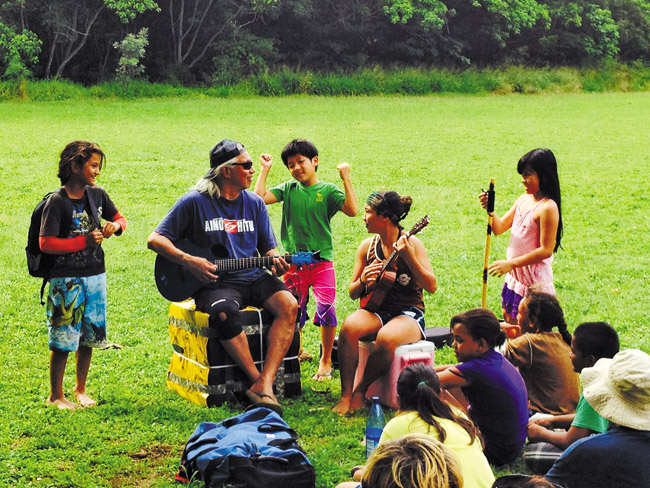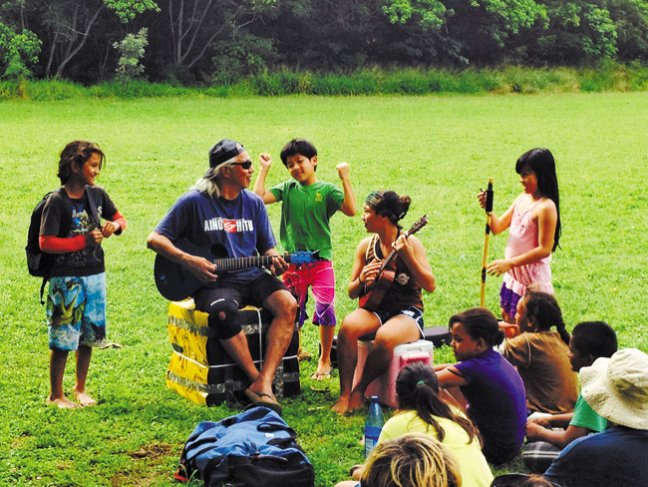Surviving With Brother Noland
You’re hiking in the woods and see pig tracks. Suddenly you’re face-to-face with a wild pig. What should you do?
a) Call the Humane Society.
b) Make sounds like a pig and become one with the animal.
c) Get off the trail.
During jellyfish influx, especially eight to 10 days after a full moon, you should:
a) Howl at the sky.
b) Take a course in marine biology.
c) Avoid the beach for two or three days. Go hiking instead.
If you need to go to the bathroom in the bush:
a) Raise your hand and ask permission.
b) Lament not going before leaving home.
c) Get off the main trail.
If you picked (c) in each scenario above, congratulations. You have good survival instincts. Or you’ve read Brother Noland’s newly released book The Hawaiian Survival Handbook, a one-of-a-kind collection of outdoor skills and techniques.
mw-nm-082014-brothernolan-1
While you might never have to escape a charging wild pig, why deny yourself the intuitive insight?
Whether you’re an armchair adventurer or experienced explorer, you’ll appreciate Noland’s native nature lessons. His knowledge comes from the wisdom of Hawaiian elders as well as tracking experts in other cultures.
Since 1996, Noland has operated a nature camp known as Hawaiian Inside Tracking (HIT). The program is offered through Noland’s Ho’ea initiative (hoeainitiative.net) that gives adults and kids a chance to learn traditional Hawaiian tracking and survival skills.
“Chances are you won’t ever have to escape a charging wild boar, or make a fire without matches, or fight off a tiger shark,” he says. “These days … the danger zone doesn’t go much beyond losing Wi-Fi or running out of mai tai mix.”
Of native survival skills, he declares, “You’ll probably never need them. But then again, you never know!”
This is Noland’s second book. His first, titled Lessons of Aloha, was published by Watermark in 1999. The collection of 40 inspiring personal stories is described as “a mixed plate of human spirit … saimin for the soul.”
The Hawaiian Survival Handbook, according to the Kamehameha Schools grad and Kalihi-Palama native, “transitions from the earlier book. It still speaks of aloha and the art of living.”
“In Hawaii, survival means more than the physical skills of finding food or shelter or fighting off predators. True survival goes deeper,” says Noland, who has three adult daughters and three grandchildren. “It is about our relationships with other people as well as with nature. Survival and aloha go hand in hand.”
He explains: “This important survival tool means learning to live correctly and behave well, so that you don’t find yourself in predicaments that put you in grave survival situations.
“In a survival situation, what enables you to survive is your attitude and state of mind — your willpower and your refusal to give up,” claims Hawaii’s answer to Henry David Thoreau.
The wilderness is no place for mind games, declares Noland, an expert outdoorsman. In the wild, there is no hierarchy of man over beast. All creatures are equal in nature.
The 151-page book, nicely illustrated by Andrew J. Catanzariti, addresses ocean, land and general skills and safety. Its quick-reading format of brief narratives followed by concise bullet-points of advice and instruction is a welcome feature.
While offering serious tips, its conversational style reflects Noland’s lighthearted personality.
On how to deal with being lost in the woods, he writes, “If you think you are lost, then you are.”
“He’s a master of the obvious, that guy,” quips publisher George Engebretson.
Yet Noland’s lessons are not frivolous or contrived. Grounded in Hawaiian cultural values, Noland honors his ancestors’ belief that nature and deities are one.
“I don’t make up this stuff,” he says. “This stuff is sacred.”
Among the more than 40 bush skills are how to survive a rip tide or undertow, read animal tracks, wayfind in the forest, and make use of native plants.
The Na Hoku Hanohano award-winning artist is as lyrical on how to collect water from plants’ condensation as he is composing music. It’s hard to separate the troubadour from the tracker. And Noland doesn’t want to be distinguished as one or the other.
“I’m both,” he says. “The musician and naturalist are two dimensions of me. This is the balance of my life. I don’t claim to know everything, but I do know a lot about growing up in Hawaii and doing things island-style.”
So no one should be surprised to see a section on “How to Fit In with the Locals” in his book.
Noland explains, “The survival skills of adjusting, adapting, blending and being aware are just as important when you visit a new neighborhood as when you go out in the forest. This is one of the greatest survival techniques you could ever learn and practice in both the natural world and the urban environment.”
His next project? A book on urban survival.
The Hawaiian Survival Handbook is available in stores late August. Preorder online at bookshawaii.net. Brother Noland performs in the Henry Kapono & Friends concert Aug. 23 at Waikiki Shell.







